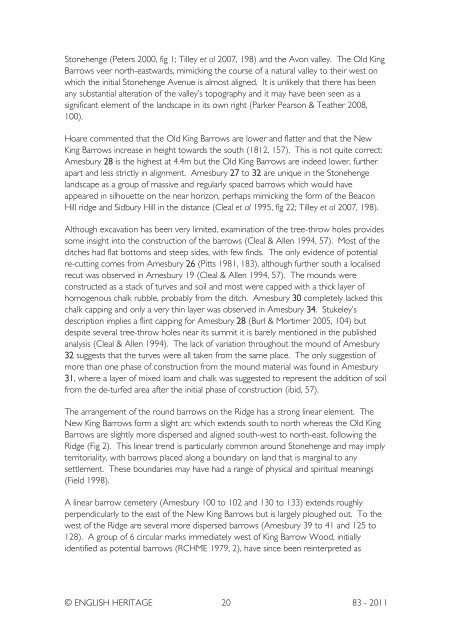King Barrow Ridge - English Heritage
King Barrow Ridge - English Heritage
King Barrow Ridge - English Heritage
You also want an ePaper? Increase the reach of your titles
YUMPU automatically turns print PDFs into web optimized ePapers that Google loves.
Stonehenge (Peters 2000, fig 1; Tilley et al 2007, 198) and the Avon valley. The Old <strong>King</strong><strong>Barrow</strong>s veer north-eastwards, mimicking the course of a natural valley to their west onwhich the initial Stonehenge Avenue is almost aligned. It is unlikely that there has beenany substantial alteration of the valley’s topography and it may have been seen as asignificant element of the landscape in its own right (Parker Pearson & Teather 2008,100).Hoare commented that the Old <strong>King</strong> <strong>Barrow</strong>s are lower and flatter and that the New<strong>King</strong> <strong>Barrow</strong>s increase in height towards the south (1812, 157). This is not quite correct:Amesbury 28 is the highest at 4.4m but the Old <strong>King</strong> <strong>Barrow</strong>s are indeed lower, furtherapart and less strictly in alignment. Amesbury 27 to 32 are unique in the Stonehengelandscape as a group of massive and regularly spaced barrows which would haveappeared in silhouette on the near horizon, perhaps mimicking the form of the BeaconHill ridge and Sidbury Hill in the distance (Cleal et al 1995, fig 22; Tilley et al 2007, 198).Although excavation has been very limited, examination of the tree-throw holes providessome insight into the construction of the barrows (Cleal & Allen 1994, 57). Most of theditches had flat bottoms and steep sides, with few finds. The only evidence of potentialre-cutting comes from Amesbury 26 (Pitts 1981, 183), although further south a localisedrecut was observed in Amesbury 19 (Cleal & Allen 1994, 57). The mounds wereconstructed as a stack of turves and soil and most were capped with a thick layer ofhomogenous chalk rubble, probably from the ditch. Amesbury 30 completely lacked thischalk capping and only a very thin layer was observed in Amesbury 34. Stukeley’sdescription implies a flint capping for Amesbury 28 (Burl & Mortimer 2005, 104) butdespite several tree-throw holes near its summit it is barely mentioned in the publishedanalysis (Cleal & Allen 1994). The lack of variation throughout the mound of Amesbury32 suggests that the turves were all taken from the same place. The only suggestion ofmore than one phase of construction from the mound material was found in Amesbury31, where a layer of mixed loam and chalk was suggested to represent the addition of soilfrom the de-turfed area after the initial phase of construction (ibid, 57).The arrangement of the round barrows on the <strong>Ridge</strong> has a strong linear element. TheNew <strong>King</strong> <strong>Barrow</strong>s form a slight arc which extends south to north whereas the Old <strong>King</strong><strong>Barrow</strong>s are slightly more dispersed and aligned south-west to north-east, following the<strong>Ridge</strong> (Fig 2). This linear trend is particularly common around Stonehenge and may implyterritoriality, with barrows placed along a boundary on land that is marginal to anysettlement. These boundaries may have had a range of physical and spiritual meanings(Field 1998).A linear barrow cemetery (Amesbury 100 to 102 and 130 to 133) extends roughlyperpendicularly to the east of the New <strong>King</strong> <strong>Barrow</strong>s but is largely ploughed out. To thewest of the <strong>Ridge</strong> are several more dispersed barrows (Amesbury 39 to 41 and 125 to128). A group of 6 circular marks immediately west of <strong>King</strong> <strong>Barrow</strong> Wood, initiallyidentified as potential barrows (RCHME 1979, 2), have since been reinterpreted as© ENGLISH HERITAGE 20 83 - 2011
















